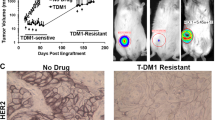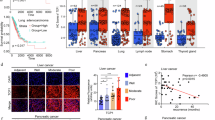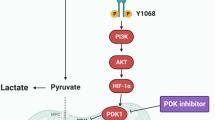Abstract
Thymidine kinase 1 (TK1), a crucial enzyme in DNA synthesis, is highly expressed in various cancers. However, the mechanisms underlying its elevated expression and the implications for tumor metabolism remain unclear. Here we demonstrate that activation of growth factor receptors enhances TK1 expression. Treatment with epidermal growth factor or insulin-like growth factor 1 induces the binding of ERK1/2 to TK1 and subsequent TK1 S13/231 phosphorylation by ERK1/2. This modification recruits ubiquitin carboxyl-terminal hydrolase 9X to deubiquitylate TK1, preventing its proteasomal degradation. Stabilized TK1 not only enhances its enzyme activity-dependent deoxythymidine monophosphate production for DNA synthesis but also promotes glycolysis independently of its enzymatic activity by upregulating phosphofructokinase/fructose bisphosphatase type 3 expression. This dual role of TK1 drives the proliferation of human hepatocellular carcinoma cells and liver tumor growth in mice. Our findings reveal a crucial mechanism by which growth factors promote tumor development through TK1-mediated DNA synthesis and glycolysis and highlight TK1 as a potential molecular target for cancer treatment.
This is a preview of subscription content, access via your institution
Access options
Access Nature and 54 other Nature Portfolio journals
Get Nature+, our best-value online-access subscription
27,99 € / 30 days
cancel any time
Subscribe to this journal
Receive 12 print issues and online access
209,00 € per year
only 17,42 € per issue
Buy this article
- Purchase on SpringerLink
- Instant access to full article PDF
Prices may be subject to local taxes which are calculated during checkout








Similar content being viewed by others
Data availability
Proteins were identified through MS by matching fragment spectra to the Swiss-Prot database (http://www.expasy.ch/sprot). MS data were deposited to iProX under accession code PXD058602. The data supporting the findings of this study are included within the main paper and Supplementary Information. Source data are provided with this paper.
References
Mannherz, W. & Agarwal, S. Thymidine nucleotide metabolism controls human telomere length. Nat. Genet. 55, 568–580 (2023).
Mathews, C. K. Deoxyribonucleotide metabolism, mutagenesis and cancer. Nat. Rev. Cancer 15, 528–539 (2015).
Buj, R. & Aird, K. M. Deoxyribonucleotide triphosphate metabolism in cancer and metabolic disease. Front Endocrinol. (Lausanne) 9, 177 (2018).
Welin, M. et al. Structures of thymidine kinase 1 of human and mycoplasmic origin. Proc. Natl Acad. Sci. USA 101, 17970–17975 (2004).
Li, Q. et al. Thymidine kinase 1 drives hepatocellular carcinoma in enzyme-dependent and -independent manners. Cell Metab. 35, 912–927 (2023).
Yamamoto, T. et al. Reduced methylation of PFKFB3 in cancer cells shunts glucose towards the pentose phosphate pathway. Nat. Commun. 5, 3480 (2014).
Ke, P. Y. & Chang, Z. F. Mitotic degradation of human thymidine kinase 1 is dependent on the anaphase-promoting complex/cyclosome–CDH1-mediated pathway. Mol. Cell. Biol. 24, 514–526 (2004).
Ke, P. Y., Kuo, Y. Y., Hu, C. M. & Chang, Z. F. Control of dTTP pool size by anaphase promoting complex/cyclosome is essential for the maintenance of genetic stability. Genes Dev. 19, 1920–1933 (2005).
Aufderklamm, S. et al. Thymidine kinase and cancer monitoring. Cancer Lett. 316, 6–10 (2012).
Xu, D. et al. The gluconeogenic enzyme PCK1 phosphorylates INSIG1/2 for lipogenesis. Nature 580, 530–535 (2020).
Wang, Z. et al. Fructose-1,6-bisphosphatase 1 functions as a protein phosphatase to dephosphorylate histone H3 and suppresses PPARα-regulated gene transcription and tumour growth. Nat. Cell Biol. 24, 1655–1665 (2022).
Lee, J. H. et al. EGFR-phosphorylated platelet isoform of phosphofructokinase 1 promotes PI3K activation. Mol. Cell 70, 197–210 (2018).
Lu, Z. & Xu, S. ERK1/2 MAP kinases in cell survival and apoptosis. IUBMB Life 58, 621–631 (2006).
Yang, W. et al. ERK1/2-dependent phosphorylation and nuclear translocation of PKM2 promotes the Warburg effect. Nat. Cell Biol. 14, 1295–1304 (2012).
Chang, Z. F., Huang, D. Y. & Chi, L. M. Serine 13 is the site of mitotic phosphorylation of human thymidine kinase. J. Biol. Chem. 273, 12095–12100 (1998).
Lee, J. H. et al. Stabilization of phosphofructokinase 1 platelet isoform by AKT promotes tumorigenesis. Nat. Commun. 8, 949 (2017).
Xu, D. et al. The evolving landscape of noncanonical functions of metabolic enzymes in cancer and other pathologies. Cell Metab. 33, 33–50 (2021).
Bian, X. et al. Regulation of gene expression by glycolytic and gluconeogenic enzymes. Trends Cell Biol. 32, 786–799 (2022).
Meng, Y. et al. Glycolytic enzyme PFKL governs lipolysis by promoting lipid droplet–mitochondria tethering to enhance β-oxidation and tumor cell proliferation. Nat. Metab. 6, 1092–1107 (2024).
Yang, W. et al. PKM2 phosphorylates histone H3 and promotes gene transcription and tumorigenesis. Cell 150, 685–696 (2012).
Wu, K. et al. Creatine kinase B suppresses ferroptosis by phosphorylating GPX4 through a moonlighting function. Nat. Cell Biol. 25, 714–725 (2023).
Li, X. et al. USP9X regulates centrosome duplication and promotes breast carcinogenesis. Nat. Commun. 8, 14866 (2017).
Qian, X. et al. KDM3A senses oxygen availability to regulate PGC-1α-mediated mitochondrial biogenesis. Mol. Cell 76, 885–895 (2019).
Xu, D. et al. The protein kinase activity of fructokinase A specifies the antioxidant responses of tumor cells by phosphorylating p62. Sci. Adv. 5, eaav4570 (2019).
Adriaenssens, E. et al. Control of mitophagy initiation and progression by the TBK1 adaptors NAP1 and SINTBAD. Nat. Struct. Mol. Biol. 31, 1717–1731 (2024).
Fischer, J., Teimer, R., Amlacher, S., Kunze, R. & Hurt, E. Linker Nups connect the nuclear pore complex inner ring with the outer ring and transport channel. Nat. Struct. Mol. Biol. 22, 774–781 (2015).
Lu, Z. et al. Activation of protein kinase C triggers its ubiquitination and degradation. Mol. Cell. Biol. 18, 839–845 (1998).
Jagarlamudi, K. K. & Shaw, M. Thymidine kinase 1 as a tumor biomarker: technical advances offer new potential to an old biomarker. Biomark. Med. 12, 1035–1048 (2018).
Brundiers, R. et al. Modifying human thymidylate kinase to potentiate azidothymidine activation. J. Biol. Chem. 274, 35289–35292 (1999).
Li, M. et al. Aldolase B suppresses hepatocellular carcinogenesis by inhibiting G6PD and pentose phosphate pathways. Nat. Cancer 1, 735–747 (2020).
Lv, D. et al. Targeting phenylpyruvate restrains excessive NLRP3 inflammasome activation and pathological inflammation in diabetic wound healing. Cell Rep. Med 4, 101129 (2023).
Xu, D. et al. PAQR3 modulates cholesterol homeostasis by anchoring Scap/SREBP complex to the Golgi apparatus. Nat. Commun. 6, 8100 (2015).
Yang, W. et al. Nuclear PKM2 regulates β-catenin transactivation upon EGFR activation. Nature 480, 118–122 (2011).
Acknowledgements
This study was supported by grants from the Ministry of Science and Technology of the People’s Republic of China (2020YFA0803300, to Z.L.), the National Natural Science Foundation of China (82188102 and 82030074, to Z.L.; 82173114 and 82372814, to Z.W.) and the Zhejiang Natural Science Foundation Key Project (LD21H160003, to Z.L.). Z.L. is the Kuancheng Wang Distinguished Chair.
Author information
Authors and Affiliations
Contributions
Z.L. conceptualized the study. Z.L., Y.S., J.T. and Z.W. designed the study and wrote the paper. Z.L. and Z.W. acquired the funding support and supervised the study. J.T., Z.W., R.S., L.L, M.L., Y.M., S.L., X.J. and Z.G. performed the experiments and statistical analysis. X.J. and M.L. reviewed the paper and provided the technical support.
Corresponding authors
Ethics declarations
Competing interests
Z.L. holds shares in Signalway Biotechnology, the supplier of rabbit antibodies targeting TK1 pS231. However, this affiliation did not influence the choice of reagents used in the study. The other authors declare no competing interests.
Peer review
Peer review information
Nature Structural & Molecular Biology thanks Hui-Kuan Lin and the other, anonymous, reviewer(s) for their contribution to the peer review of this work. Primary Handling Editor: Sara Osman, in collaboration with the Nature Structural & Molecular Biology team.
Additional information
Publisher’s note Springer Nature remains neutral with regard to jurisdictional claims in published maps and institutional affiliations.
Extended data
Extended Data Fig. 1 RTK activation via ERK signaling enhances TK1 expression.
Immunoblotting with the indicated antibodies was performed. (a) The indicated tumor cells were serum-starved for 12 h and then stimulated with or without IGF-1 (100 ng/ml) for the indicated periods of time, quantification of TK1 levels is shown. (b) The GBM cells LN229, U251, U87 were serum-starved for 12 h and then stimulated with or without EGF (100 ng/ml) for the indicated periods of time, quantification of TK1 levels is shown. (c) The indicated tumor cells were serum-starved for 12 h and then stimulated with or without EGF (100 ng/ml) for the indicated periods of time. The mRNA expression levels of the TK1 were measured using qPCR. Data represent the mean ± SD of three biologically independent experiments, analyzed by the one-way ANOVA. (d) Huh7 cells were pre-treated with or without AG1478 (5 μM), U0126 (10 μM), MK2206 (10 μM), SP600125 (25 μM) for 30 min before EGF (100 ng/ml) treatment for 2 h, quantification of TK1 levels is shown.
Extended Data Fig. 2 ERK-mediated TK1 S13/231 phosphorylation stabilizes TK1.
Immunoprecipitation and immunoblotting with the indicated antibodies were performed. (a) Huh7 cells stably transfected with or without Flag-TK1 were serum-starved and treated with or without EGF (100 ng/ml) for the indicated periods of time. (b) Protein sequences of TK1 and the ERK1/2 recognized motif (red labeled) predicted by Scansite. (c) Immunohistochemical analyses of human HCC samples were performed with the indicated antibody in the presence or absence of a blocking peptide for TK1 pS231. Representative images from three independent experiments are shown. (d) Endogenous TK1-depleted Huh7 cells were reconstituted with WT Flag-rTK1, Flag-rTK1 S13A/S231A or Flag-rTK1 V23A/L25R/L137R/L139R and then stimulated with or without EGF (100 ng/ml). (e, f) HCC cells were stably transfected with WT Flag-TK1 and then pre-treated with or without U0126 (10 μM), RO-3306 (5 μM) for 30 min before EGF (100 ng/ml) treatment for 2 h. (g) Endogenous TK1-depleted Huh7 cells were reconstituted with WT Flag-rTK1, Flag-rTK1 S13D/S231D and then stimulated with or without CHX (100 ng/ml) for the indicated periods of time. Quantification of TK1 levels initial protein levels is shown. Data represent the mean ± SD of three biologically independent experiments analyzed by two-way ANOVA.
Extended Data Fig. 3 USP9X deubiquitylates TK1, thus stabilizing its expression.
(a) Huh7 cells were treated with MG132 (10 μM) for the indicated time. Immunoblotting with the indicated antibodies was performed. (b) Endogenous TK1-depleted Huh7 cells with reconstituted expression of indicated Flag-rTK1 proteins were transfected with HA-Ub and stimulated with or without EGF (100 ng/ml) for 1 h. Cells were harvested with a guanidine-HCl-containing buffer after treated with MG132 (10 μM) for 6 h. Immunoprecipitation and immunoblotting with the indicated antibodies were performed. (c) Selected peptide hits of TK1-associated proteins in Huh7 cells as identified by mass spectrometry were presented. (d) Endogenous TK1-depleted Huh7 cells with reconstituted expression of indicated Flag-rTK1 proteins were stimulated with or without EGF (100 ng/ml) for 1 h. Cells were treated with MG132 (10 μM) for 6 h before harvest. Immunoprecipitation and immunoblotting with the indicated antibodies were performed.
Extended Data Fig. 4 Elevated TK1 promotes dTMP production and glycolysis.
(a) Huh7 cells with endogenous TK1 depletion and reconstituted expression of the indicated Flag-rTK1 proteins were subjected to immunoblotting analyses with the indicated antibodies (top). The mRNA expression levels of the TK1 were measured using qPCR (bottom). Data are means ± SD of three biologically independent replicates, analyzed by one-way ANOVA. (b) Huh7 cells stably transfected with endogenous TK1 depletion and reconstituted expression of the indicated Flag-rTK1 proteins were subjected to 15N2-labeled pyrimidine intermediates dTMP, dTDP, dTTP measurements by UPLC-HRMS. Data are means ± SD of three biologically independent replicates, analyzed by two-sided t-test. (c) Bacterially purified GST-TK1 proteins as indicated were subjected to TK1 enzymatic activity measurement. (d) TK1 proteins purified from bacteria were analyzed by immunoblotting analyses with an anti-TK1 antibody (left). An in vitro kinase assay was performed by mixing purified WT Flag-TK1 tetramer or the tetramer formed with WT Flag-TK1 and GST-TK1 S13A/S231A or GST-TK1 V23A/L25R/L137R/L139R with or without purified active Flag-ERK2 R67S. The enzymatic activity of TK1 was measured (right). Data in c, d represent the means ± SD of 6 independent experiments analyzed by two-way ANOVA.
Extended Data Fig. 5 TK1 upregulation promotes HCC cell proliferation.
(a) LM3 cells with stable expression of the control shRNA or ERK1/2 shRNAs were stimulated with or without EGF (100 ng/ml) for indicated periods. Immunoblotting with the indicated antibodies was performed. (b) LM3 cells with endogenous TK1 depletion and reconstituted expression of the indicated Flag-rTK1 proteins were treated with or without EGF (100 ng/ml) for 2 h. Immunoblotting with the indicated antibodies was performed. (c) LM3 cells were stably transfected with or without USP9X shRNA or Flag-TK1 KEN-KAA protein. Immunoblotting with the indicated antibodies was performed. (d) LM3 cells with endogenous TK1 depletion and reconstituted expression of the indicated Flag-rTK1 proteins were treated with or without EGF (100 ng/ml) for indicated times. Cell proliferations were measured at the indicated time. (e, f) LM3 cells with endogenous TK1 depletion and reconstituted expression of the indicated Flag-rTK1 proteins were measured for cell proliferation (e) and colony formation (f). Data in d, e and f are means ± SD of three to six biologically independent replicates, analyzed by two-way ANOVA (d, e) or one-way ANOVA (f).
Extended Data Fig. 6 TK1 promotes tumor growth with elevated dTMP.
(a, b) Huh7 cells with or without endogenous TK1 depletion and reconstituted expression of the indicated Flag-rTK1 proteins were subcutaneously injected into 6-week-old male athymic BALB/c nude mice, n = 5 per group. Tumors were shown in (a). Tumor weight (b, Left), and tumor volume (b, Right) were measured. Data represent means ± SD, analyzed by one-way ANOVA (b, Left) or two-way ANOVA (b, Right). (c, d) Huh7 cells with or without endogenous USP9X depletion and reconstituted expression of Flag-TK1 KEN-KAA proteins were subcutaneously injected into 6-week-old male athymic BALB/c nude mice, n = 5 per group. Tumors were shown in (c). Tumor weight (d, Left), tumor volume (d, Right) was measured. Data represent means ± SD, analyzed by one-way ANOVA (d, Left) or two-way ANOVA (d, Right).
Supplementary information
Source data
Source Data Fig. 1
Unprocessed western blots.
Source Data Fig. 2
Unprocessed western blots.
Source Data Fig. 3
Unprocessed western blots.
Source Data Fig. 4
Unprocessed western blots.
Source Data Fig. 1
Statistical source data.
Source Data Fig. 2
Statistical source data.
Source Data Fig. 3
Statistical source data.
Source Data Fig. 4
Statistical source data.
Source Data Fig. 5
Statistical source data.
Source Data Fig. 6
Statistical source data.
Source Data Fig. 7
Statistical source data.
Source Data Fig. 8
Statistical source data.
Source Data Extended Data Fig. 1
Unprocessed western blots.
Source Data Extended Data Fig. 2
Unprocessed western blots.
Source Data Extended Data Fig. 3
Unprocessed western blots.
Source Data Extended Data Fig. 4
Unprocessed western blots.
Source Data Extended Data Fig. 5
Unprocessed western blots.
Source Data Extended Data Fig. 1
Statistical source data.
Source Data Extended Data Fig. 2
Statistical source data.
Source Data Extended Data Fig. 4
Statistical source data.
Source Data Extended Data Fig. 5
Statistical source data.
Source Data Extended Data Fig. 6
Statistical source data.
Rights and permissions
Springer Nature or its licensor (e.g. a society or other partner) holds exclusive rights to this article under a publishing agreement with the author(s) or other rightsholder(s); author self-archiving of the accepted manuscript version of this article is solely governed by the terms of such publishing agreement and applicable law.
About this article
Cite this article
Tao, J., Wang, Z., Shi, R. et al. ERK–USP9X-coupled regulation of thymidine kinase 1 promotes both its enzyme activity-dependent and its enzyme activity-independent functions for tumor growth. Nat Struct Mol Biol 32, 853–863 (2025). https://doi.org/10.1038/s41594-024-01473-6
Received:
Accepted:
Published:
Issue Date:
DOI: https://doi.org/10.1038/s41594-024-01473-6



